Choosing the right rod and reel
When I started this series I said it would be a three part series and that would be it, but as often happens with the passage of time, you always want to add a little more. There’s also been some enquiries posted on the threads and maybe I can address those questions as a reference for others that are bound to arise in time.
What has also happened since I started the series, I decided to upgrade my own rods. I have gone to a lot of care and attention in choosing the new ones bearing in mind where I will be fishing and what sizes of lures I will be fishing with. It’s a bit like golf in that you can’t just buy one club that will do it all, although the late-comedian Max Miller was reputed to turn up at Stoke Poges with just a #7 iron and challenge anyone for £50 a round. Apparently, he rarely lost.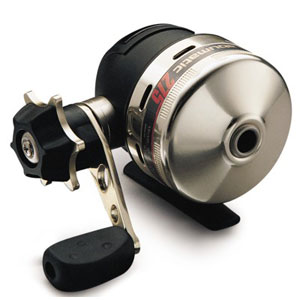
I touched on rods slightly in the first part so here I want to expand a little.
First the baitcasters
These are the rods with the strangely shaped triggers under the handle and you use the entire rod upside-down all the time, casting and retrieving. The type of reel suited to this style of rod is the multiplier or low-profile baitcasting reel. You can use a closed-face casting reel, but having owned an Abu for many years and rarely using it I really don’t recommend them unless you intend fishing very light indeed, up to just 10 grams or so.
The two things you can say about a baitcasting rod are A) they are extremely accurate at casting once you have mastered the multiplier and B) you can get them in very heavy casting weights, ie: jerkbait style rods. I think they’re better for heavier weighted lures, say above 60 grams, but not because of the rod. It’s the reel that makes the difference, but I’ll discuss that in the bit on spinning rods.
As I said in the first part, you can get baitcasters in lengths up to 9 feet, but I reckoned 7 feet is the length that would suit me best. So most of my rods apart from a 6 ft and a 6½ ft are now 7 feet in length. I reckoned on a range of casting weights too from light to heavy so I have them casting from as little as 8 grams to around 30 grams, then a couple cast from 14 to 56 grams and the heaviest one from 60 to 110 grams. Even the lightest is what Americans would call a “medium/heavy” rod.
The lightest and is good for chucking out spinnerbaits and light spoons mainly although it will handle some of the new small rubber lures. Anything to around 1 ounce (30 grams) in weight. The E.T. Stinger is one of the middleweight rods and although it is rated from 14 to 42 grams, I have cast 60 gram lures on this rod with ease so don’t always take the casting weights stated as gospel. The heaviest rod is the Fox Special Lure rod and in practice will cast 30 grams to well over 110 grams. In fact, one jerkbait I have weighs in at 160 grams and it cast that reasonably well also. It’s a Jerkbait rod in everything but name.
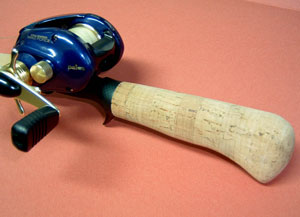 You will notice that as the rods get heavier the handles get longer (see header picture). Short handles are fine on light rods, but as it gets heavier, if you want longer casts, you sometimes need to get two hands on it and so need the extra length of handle. The exception to this handle length rule is the shortest Fox Dave Kelbrick Hitman, which has a pistol grip and casts 15 – 50 grams, but mainly short casts.
You will notice that as the rods get heavier the handles get longer (see header picture). Short handles are fine on light rods, but as it gets heavier, if you want longer casts, you sometimes need to get two hands on it and so need the extra length of handle. The exception to this handle length rule is the shortest Fox Dave Kelbrick Hitman, which has a pistol grip and casts 15 – 50 grams, but mainly short casts.
The entire rod weighs just 4 ozs and at 6 foot it’s a nice length to take on a strolling trip and get under a lot of overhanging branches. It comes in one piece so if you buy one make sure it will fit in the car. Also, it is useful on the boat too where you don’t need enormous casts and it takes small low-profile baitcasting reels like the Shimano Citica styles or a Quantum Tour PT that I now use with it.
Now the spinning rods
Why the two types? Well, they have different actions and you use different methods of retrieval with them. Sometimes it’s nice just to take the spinning rods with fixed spool reels and at other times, it’s nice to stick to casting with multipliers. You might think at first that fishing with fixed spool reels guarantees you longer casts, but let me assure you that once you master the multiplier, one’s as good as the other.
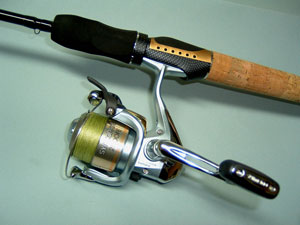 I have never seen the value in having long spinning rods, that is rods of 10 feet and longer, but this does seems to be a very British trait. In the past I made 9 feet my maximum, but now I have got rid of the 9 feet rods and am replacing them with 8 feet ones and shorter. Again there is always the exception and I have a little light Daiwa Triforce at 6½ feet just for flicking out very light spinners for perch and it’s surprising how well that casts!
I have never seen the value in having long spinning rods, that is rods of 10 feet and longer, but this does seems to be a very British trait. In the past I made 9 feet my maximum, but now I have got rid of the 9 feet rods and am replacing them with 8 feet ones and shorter. Again there is always the exception and I have a little light Daiwa Triforce at 6½ feet just for flicking out very light spinners for perch and it’s surprising how well that casts!
So from the very lightest again I have another Abu Conolon (popular these in the USA) of 8′ that casts from a feather to 12 grams (pc right). This is great for perch and has a nice through action, but I have caught the odd pike to around 5 lbs on it before now. This one is a through-actioned rod. I also have an older Daiwa Samurai 7 foot rod for lightweight spinning and this is also a nice rod just to take along the bank anytime with small spinners for the perch; it casts up to 18 grams.
Then there is the Shimano Technium DX and again at 8 feet it is not that heavy from a spinning rod point of view, casting 15 – 40 grams. I have also added a Zalt (Swedish) rod of 8 foot that casts upto 70 grams, but as I said before, I much prefer a baitcaster and multiplier for these kind of weights. The main reason being is that with a multiplier you have direct contact from spool to fish, albeit over a few rings. With a fixed spool it has to go at right-angles around a roller and a bale arm and I just don’t trust the mechanics of that too much with really heavy weights.
So that’s more or less my lineup now, 3 baitcasters at 7 feet each, 1 at 6½ft and two at 6 ft in length. Plus the spinning rods, four at 8 feet, one at 7 feet, with the little fun one again at 6½ feet. In those I have a rod for each and every job. Sounds too much, maybe, but I can’t resist them.
Multiplier reels
There are several companies that make good multipliers, Shimano and Daiwa amongst them. Since 1970, though, I have held an undying love for ABU Ambassadeurs. I currently have three, all 5000 range (the 6000s have wider spools otherwise are the same and I had one of those in the 70s). Furthermore, mine are all right hand wind in that you hold the rod in your left hand and wind in with the right hand.
This flies against a lot of British thought that left hand winds are the best since you cast and retrieve all of the time with the rod in your right hand. I have a Daiwa Procaster reel to do that. I do think this is because UK anglers grew up with spinning reels that you wind in with the left hand. However, I am now convinced that right handed wind multipliers (for right handed people that is) are the best.
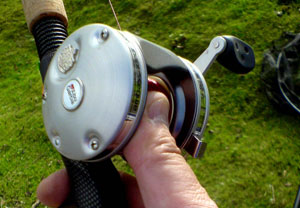
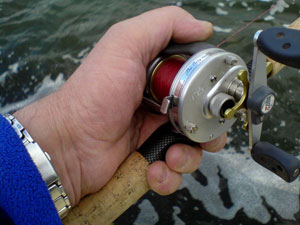
You cast holding the rod in your right hand with just the forefinger around the trigger and thumb on the spool. After casting you then transfer the rod to your left hand with the reel’s side plate in the palm of your left hand, two or even three fingers in front of the trigger underneath. With this grip, you can rest your thumb on top of the multiplier and you have a great grip on the rod in case you get a savage take. (See pictures above.)
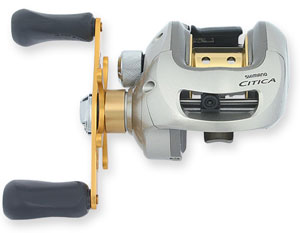 The Ambassadeurs are the full-on multipliers, but you can buy low-profile multipliers or what are sometimes referred to as casting reels. Such reels are, as previously mentioned, the Shimano Calais and Citica styles or the Daiwa Procaster and even the John Wilson Six-Shooter reel. Unfortunately, not many are readily available in this country so you may have to widen the search.
The Ambassadeurs are the full-on multipliers, but you can buy low-profile multipliers or what are sometimes referred to as casting reels. Such reels are, as previously mentioned, the Shimano Calais and Citica styles or the Daiwa Procaster and even the John Wilson Six-Shooter reel. Unfortunately, not many are readily available in this country so you may have to widen the search.
The low profiles do take less line, but still enough for all the casting you are going to do. The spools are smaller in diameter and often easier to control and to help even further, many have magnetic overrun control. This will give you even greater confidence whilst you are learning.
Spinning reels
You probably have one already quite suitable for spinning. It doesn’t need to be a huge monster of a reel, I’m thinking now of the big pit long-distance reels that carpers use, those are totally unsuitable in my mind. Something along the lines of a 4000 size whether Daiwa or Shimano for the heaviest rod and a 2500 size for the lighter rods.
One of the reasons I don’t like going too heavy with spinning rods is because I don’t want to use too strong a line. Monofilament to around 12 lbs is quite suitable and braid to 30lbs is even better, but mind what type of braid you buy because not all are suitable for spinning reels. Some suffer from terrible line twist and will cause wind knots in the line so get one that is round in its form and keeps its when compressed.
Loading with braid
See also my more recent article “Loading Lines on Reels Part 3“
Many braids on the market are sold on 150 metre spools. That’s far too much to put on a reel, but you can get at least two loads out of that. You can even take braid off a reel after a bit of use and reverse it to use the portion underneath that has had hardly any use, it doesn’t suffer like monofilament does. Used like this, braid is cheaper than nylon.
Why only 75 yards? The furthest you are going to cast any lure to have some sort of control over it’s movement is 50 yards. If you allow 50% as much again for the very slight bit of wastage (maybe 2-3 inches every time you retie a trace on) and just in case a fish larger than you expected goes on a determined run. So at the maximum, you only need 75 yards and if you can’t stop a fish then, take up golf. (Sorry!)
Try to measure out two points, in the garden maybe, 10 yards apart (use a proper measure) and place a bankstick in the ground at each point. Now, unwind the braid having tied it to one bankstick and go around them until you have 7 strands of braid hanging (=70yards) then guess around half way (5yards) on the next and cut it. Wet the braid first with a hose or rose sprinkler and wind it onto the reel under a fair bit of pressure applied by your spare finger and thumb.
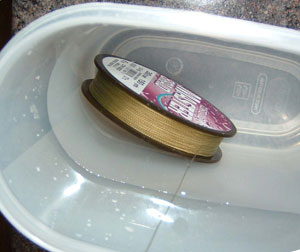 Ideally, braid should sit on a few coils of normal monofilament first, so load up with that leaving enough room for the braid on top. If you have too much on the spool, try unwinding it onto a spare reel or spool, take some backing off when you get down to it then rewind the braid back on afterwards. It’s always worth keeping a spare spool empty just for this purpose or wind it onto an old centrepin.
Ideally, braid should sit on a few coils of normal monofilament first, so load up with that leaving enough room for the braid on top. If you have too much on the spool, try unwinding it onto a spare reel or spool, take some backing off when you get down to it then rewind the braid back on afterwards. It’s always worth keeping a spare spool empty just for this purpose or wind it onto an old centrepin.
If you do this once from a 150 yards spool, then there should be 75yards left at least. So next time you can just throw the spool into something like one of those tall slim plastic food containers half filled with water and wind it onto the spool from there. Even after doing all of this, treat the first few casts with caution, short casts getting longer and longer as the braid beds in properly on the retrieve.
More to follow in Part 5 – Rubber lures and jerkbaits.










